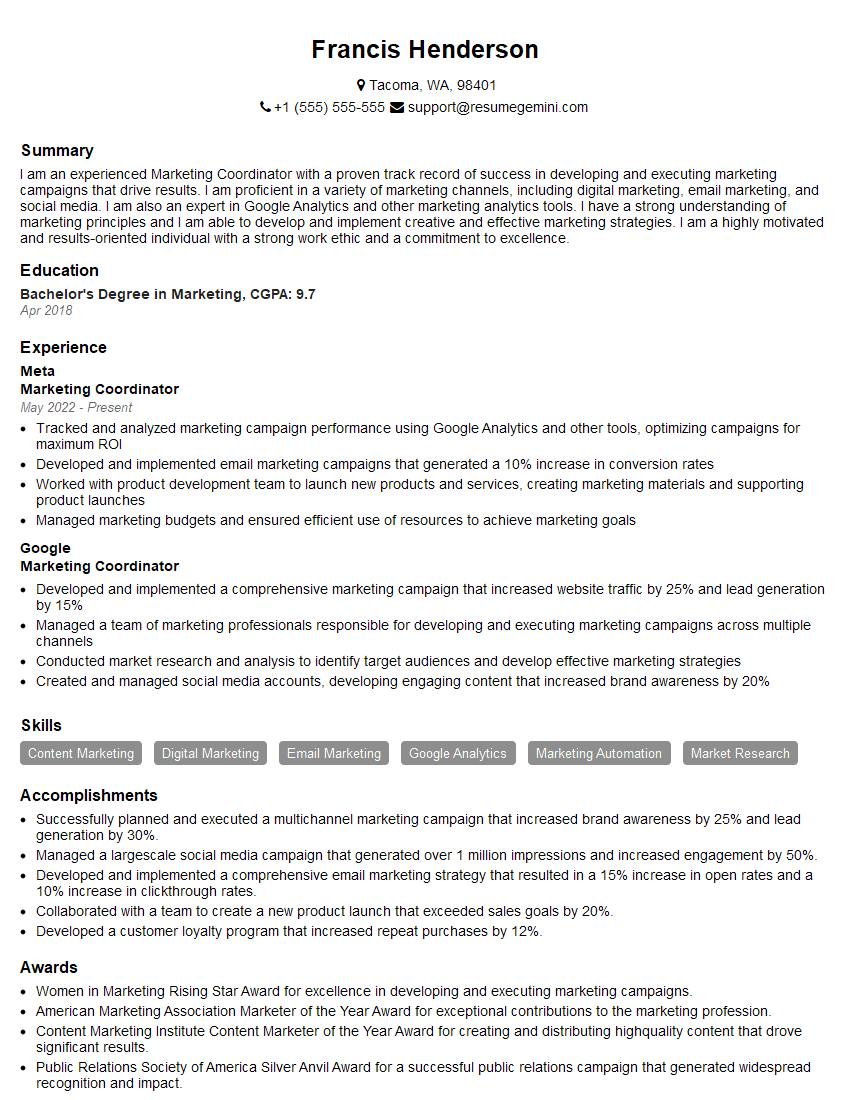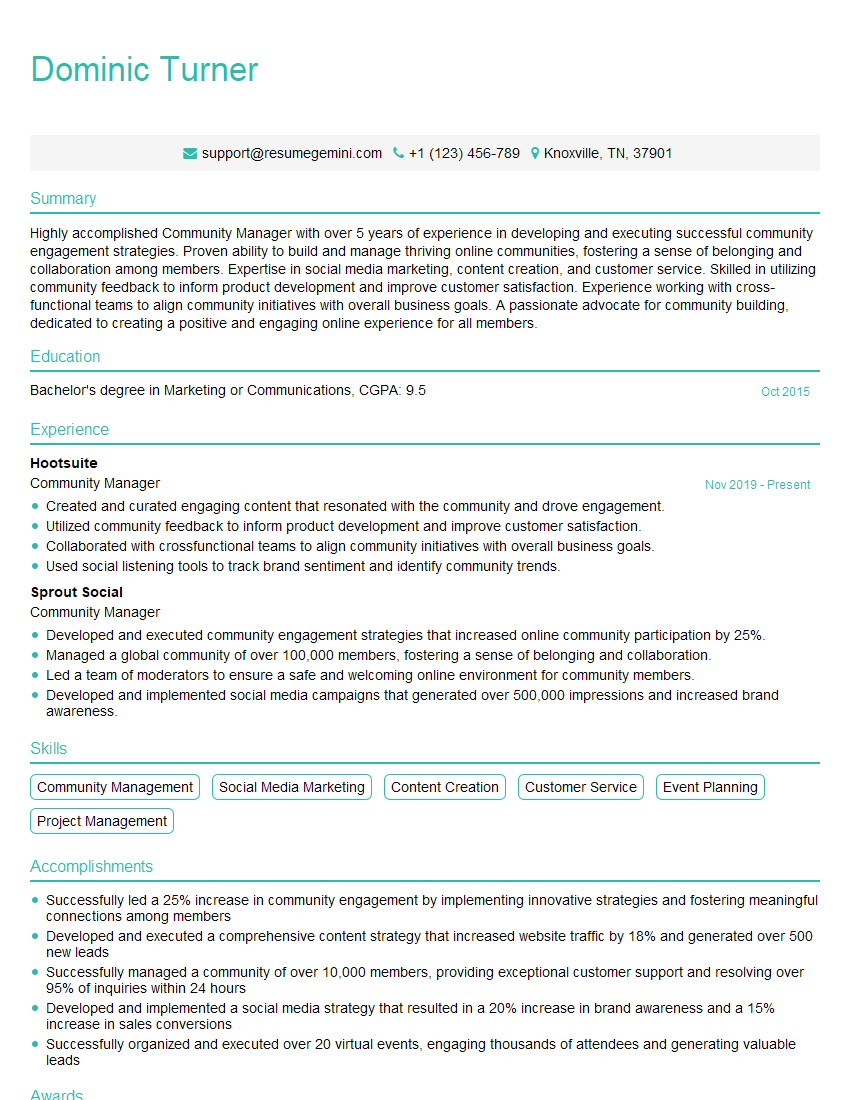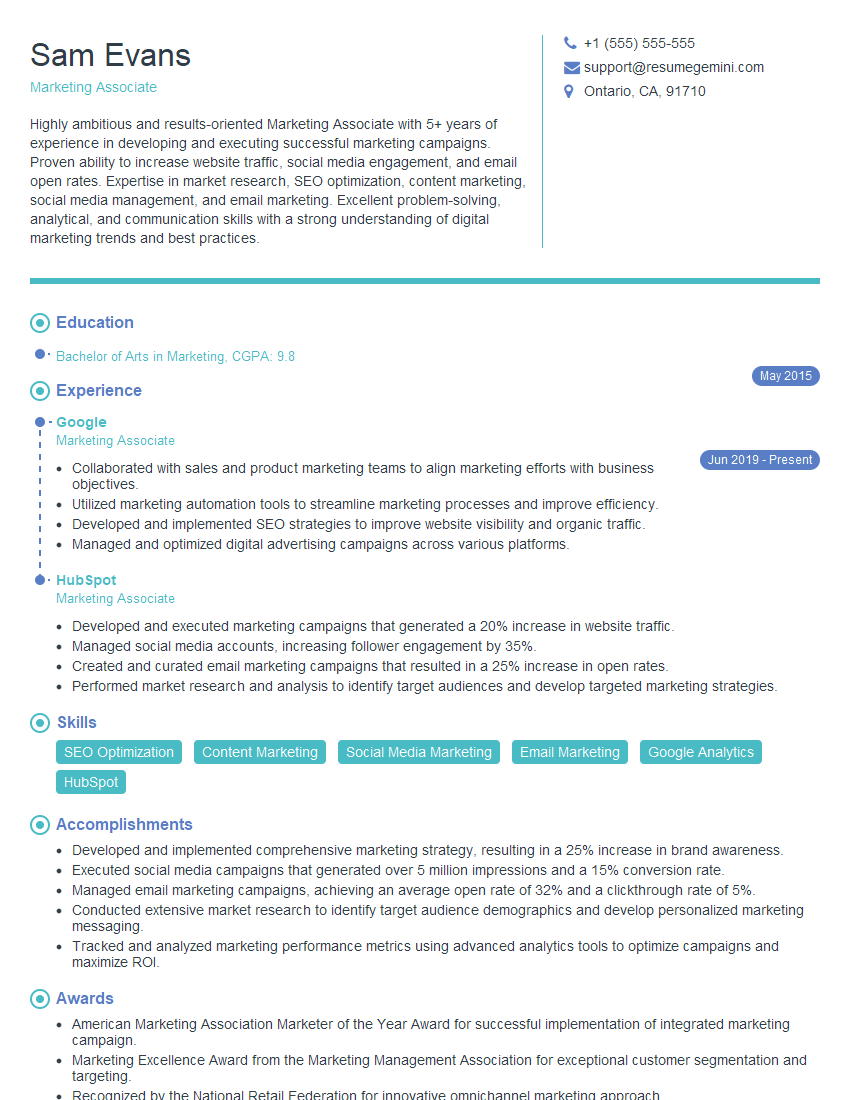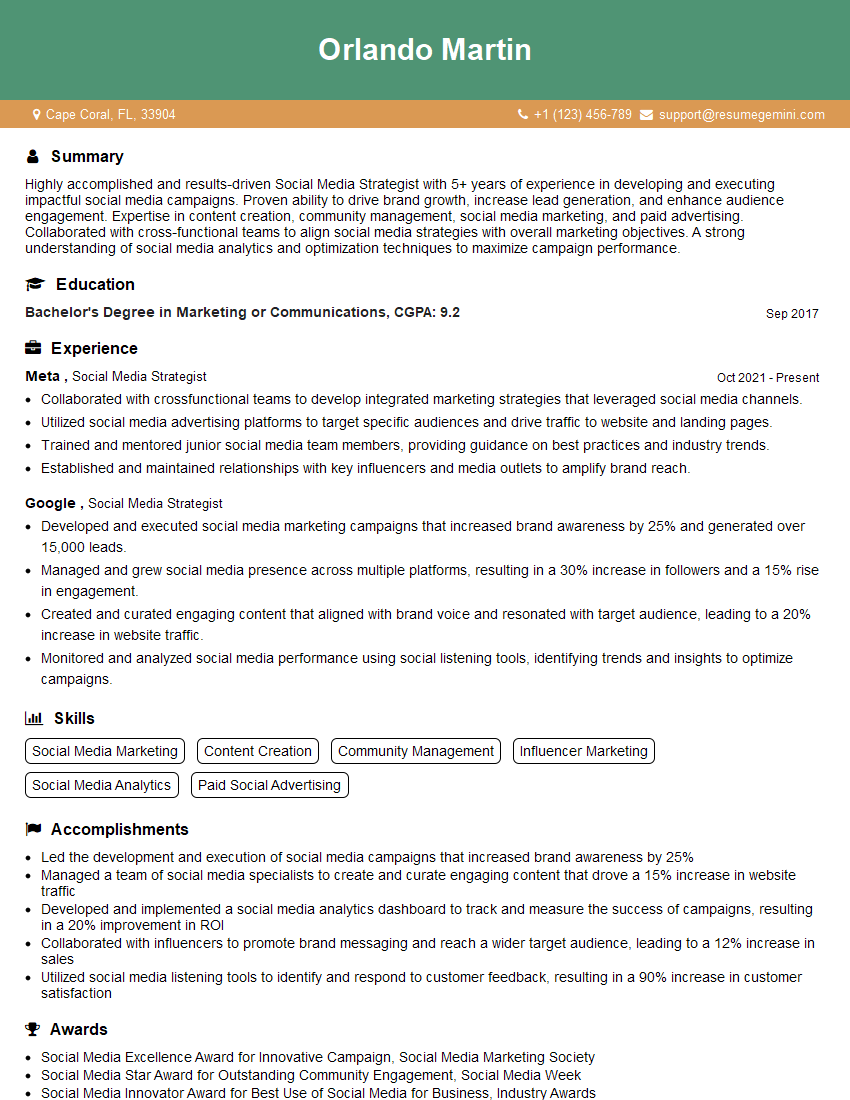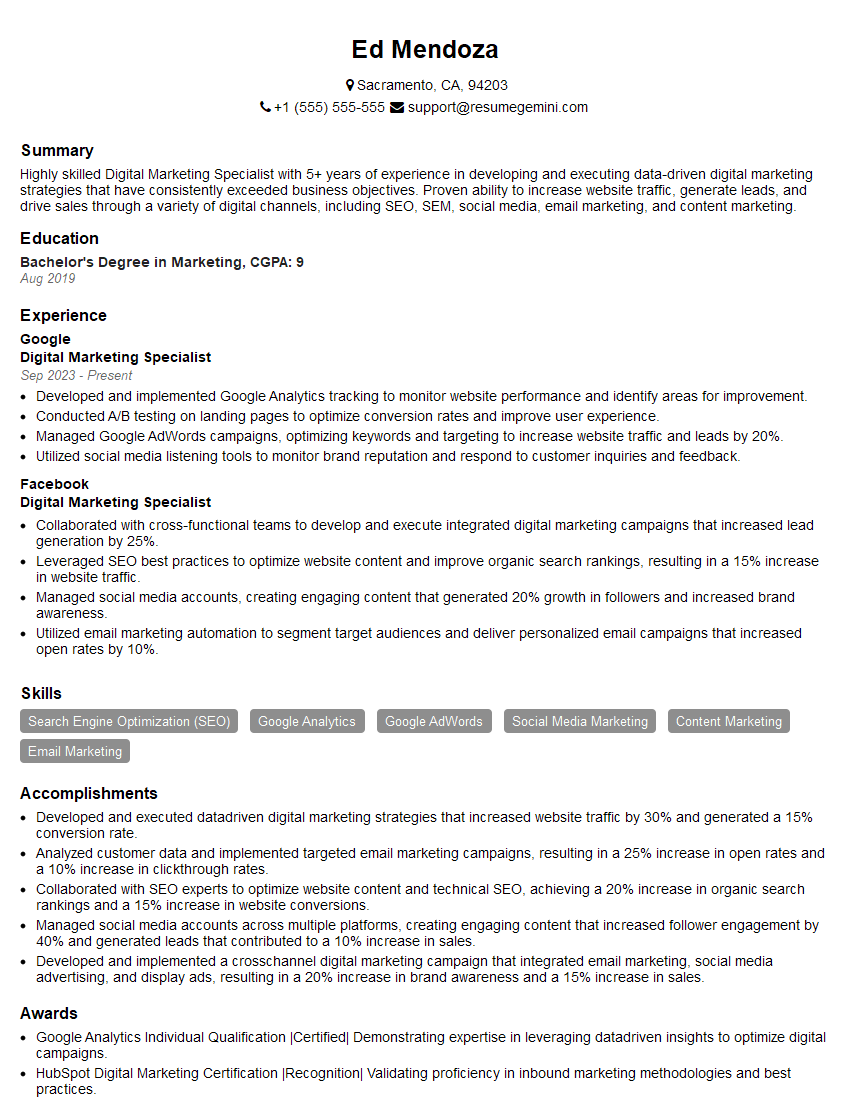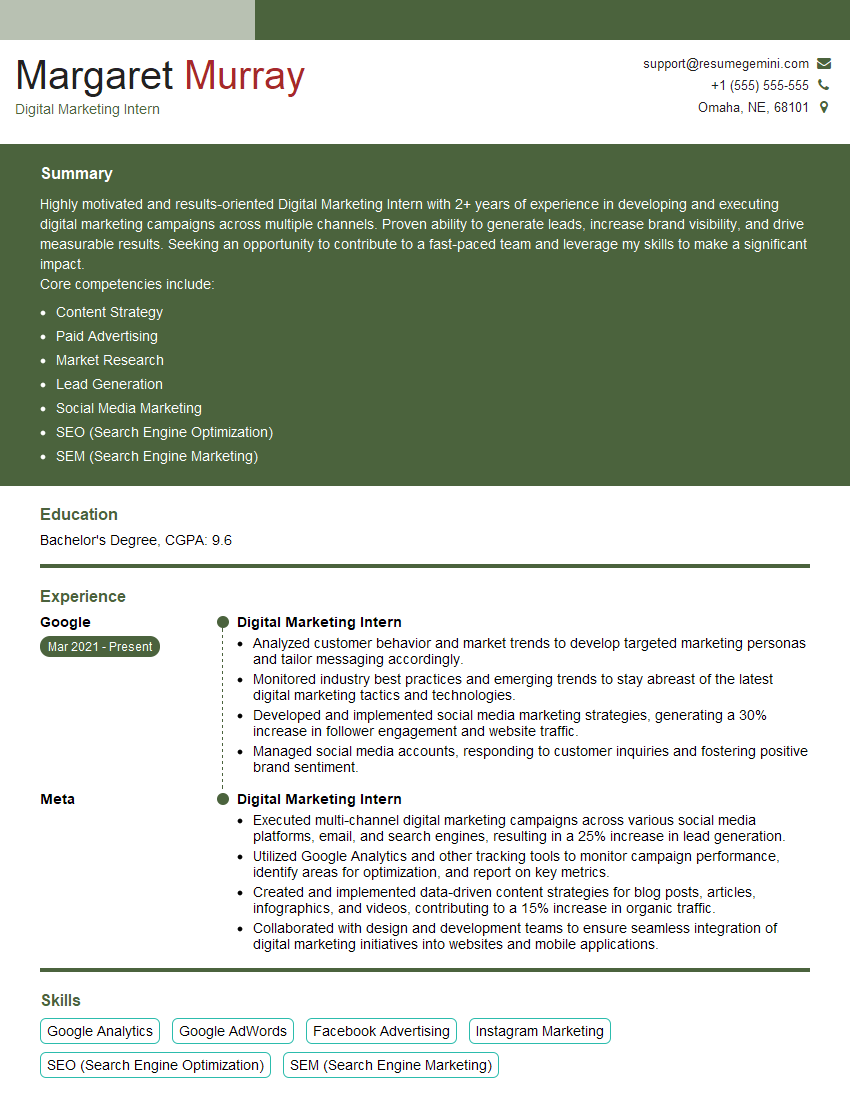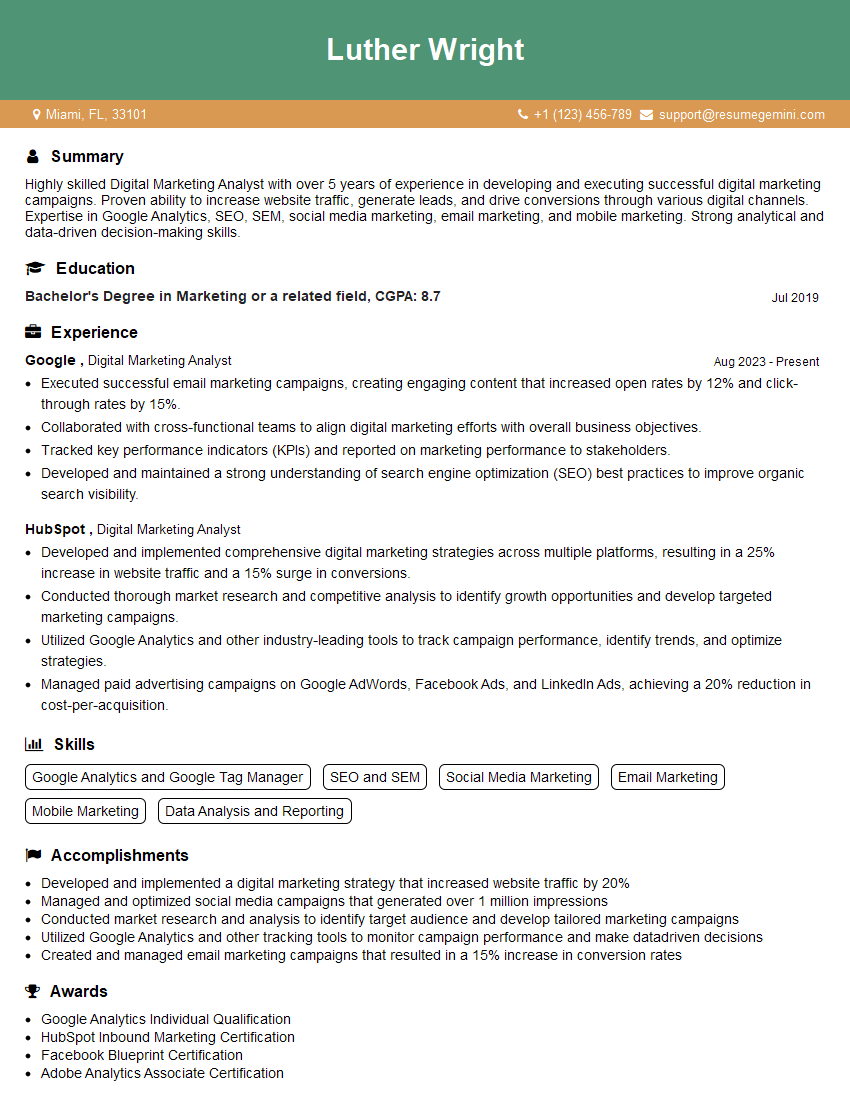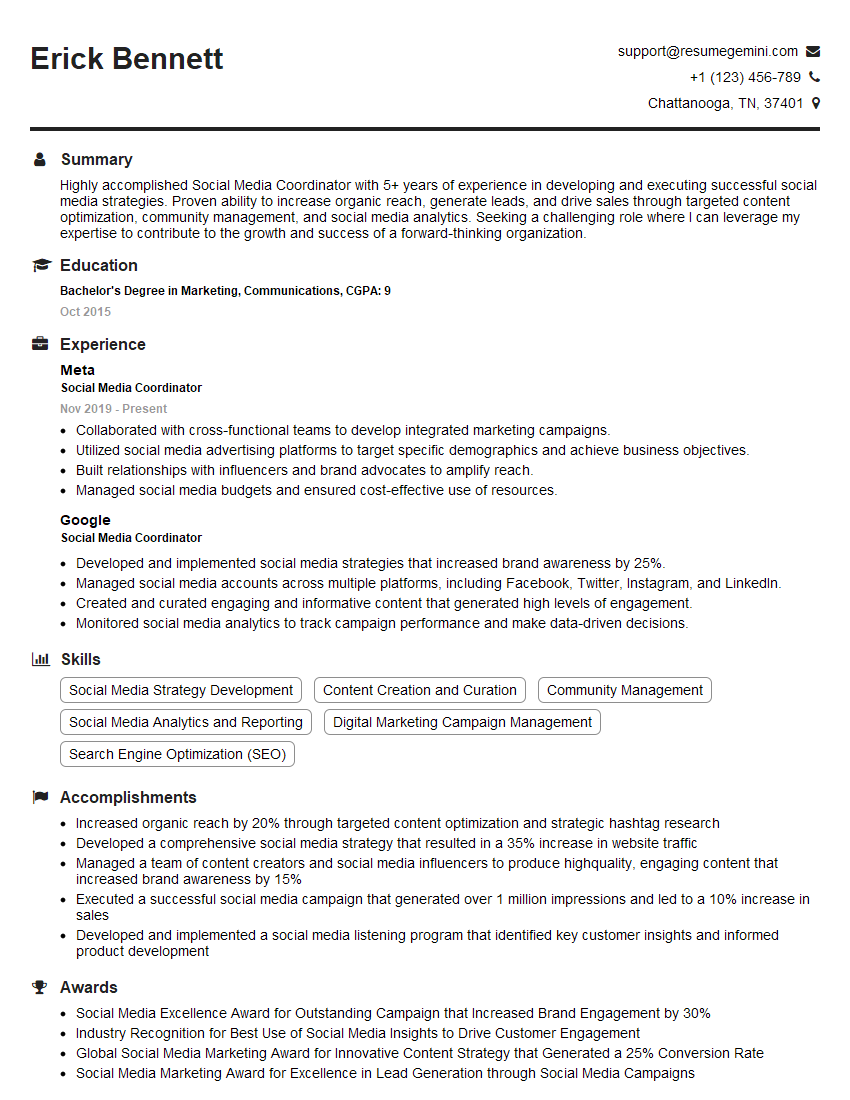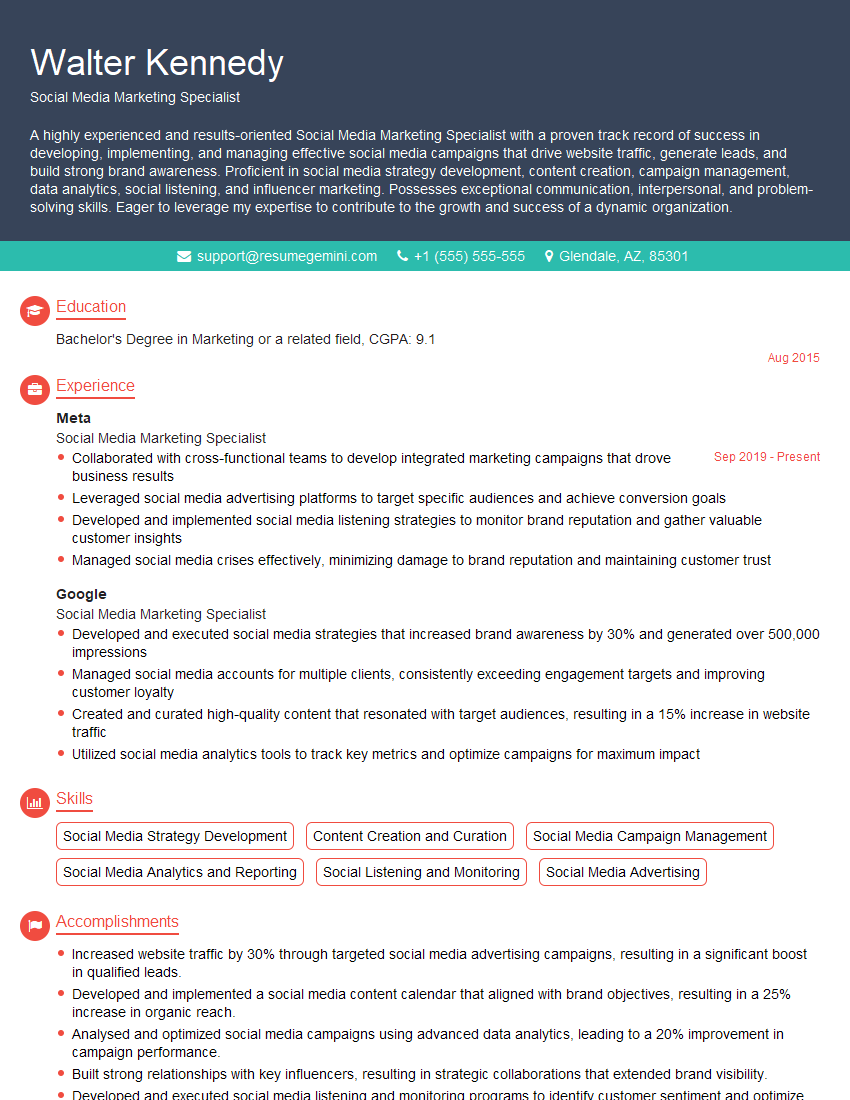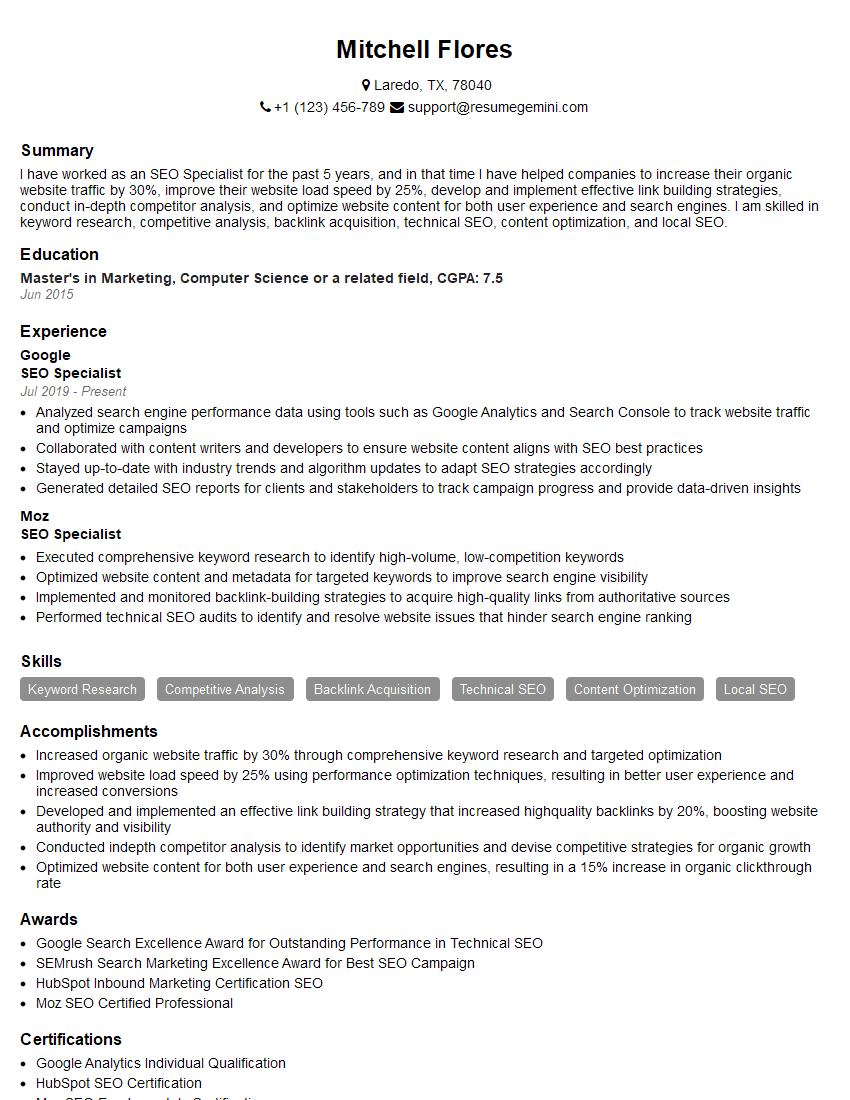Feeling uncertain about what to expect in your upcoming interview? We’ve got you covered! This blog highlights the most important Experience with Social Media and Marketing interview questions and provides actionable advice to help you stand out as the ideal candidate. Let’s pave the way for your success.
Questions Asked in Experience with Social Media and Marketing Interview
Q 1. Explain your experience with different social media platforms (e.g., Facebook, Instagram, Twitter, LinkedIn, TikTok).
My experience spans a wide range of social media platforms, each with its unique audience and approach. I’ve managed profiles and campaigns across Facebook, Instagram, Twitter, LinkedIn, and TikTok. For instance, on Facebook, I’ve focused on building communities through engaging content and targeted advertising, utilizing features like Facebook Groups to foster discussions. Instagram presented opportunities for visually-driven storytelling through high-quality images and Reels, enhancing brand awareness and driving engagement. Twitter provided a platform for real-time interaction, crisis management, and rapid response marketing. LinkedIn has been instrumental in B2B lead generation and professional networking, leveraging its features for content marketing and influencer outreach. Finally, TikTok provided a space to connect with younger demographics via short-form video content, emphasizing trends and viral challenges.
I understand that each platform requires a tailored strategy. For example, the ideal content for LinkedIn, focused on professional development, differs greatly from the short, engaging video content that thrives on TikTok.
Q 2. Describe your experience developing and implementing social media strategies.
Developing and implementing social media strategies involves a multi-step process. It starts with a thorough understanding of the target audience, brand goals, and competitive landscape. I begin by defining clear objectives, whether it’s increasing brand awareness, driving sales, or improving customer engagement. This is followed by a detailed content calendar outlining the type of content, posting schedule, and platform-specific strategies. For instance, for a client in the food industry, we might focus on high-quality food photography on Instagram, while employing informative blog posts and recipes on Facebook.
Implementation involves scheduling posts using tools like Buffer or Hootsuite, actively engaging with the audience, monitoring analytics, and adapting the strategy based on performance. A successful social media strategy is not static; it’s iterative, constantly refined based on data and audience feedback. I’ve found that A/B testing different content formats and posting times is crucial to optimizing campaign performance.
Q 3. How do you measure the success of a social media campaign?
Measuring the success of a social media campaign relies on carefully selected Key Performance Indicators (KPIs) and a clear understanding of the campaign objectives. Simply tracking follower count isn’t enough. For example, if the objective is to drive sales, we’ll primarily look at conversion rates from social media traffic. If the goal is brand awareness, we’ll track metrics like reach, impressions, and engagement (likes, comments, shares).
I typically use a combination of quantitative and qualitative data. Quantitative data includes metrics like website traffic, lead generation, and sales figures. Qualitative data includes analyzing sentiment in comments and messages, monitoring brand mentions, and gathering feedback from surveys and focus groups. This holistic approach provides a comprehensive understanding of campaign effectiveness.
Q 4. What key performance indicators (KPIs) do you track for social media marketing?
The KPIs I track vary depending on the campaign objectives but generally include:
- Reach and Impressions: How many unique users saw the content.
- Engagement Rate: Likes, comments, shares, and other interactions, relative to the audience size.
- Website Clicks and Traffic: How many users clicked through from social media to the website.
- Lead Generation: The number of leads generated through social media campaigns.
- Conversion Rate: The percentage of users who completed a desired action (e.g., purchase, sign-up).
- Brand Mentions and Sentiment: Tracking what people are saying about the brand online and the overall sentiment (positive, negative, neutral).
- Return on Investment (ROI): A critical metric measuring the profitability of the social media marketing efforts.
Tracking these KPIs allows for data-driven decision-making and continuous optimization of the social media strategy.
Q 5. How do you handle negative comments or feedback on social media?
Handling negative comments or feedback requires a calm, professional, and empathetic approach. Ignoring negative feedback is never an option. My first step is to acknowledge the comment and thank the user for their feedback. Then, I assess the situation. If it’s a valid criticism, I offer a sincere apology and outline steps to address the issue. For example, if a customer received a damaged product, I’d offer a replacement or refund and ensure the issue doesn’t happen again. If the comment is abusive or irrelevant, I’ll respond with a brief, polite statement, and may choose to delete it if it violates community guidelines.
Transparency and responsiveness are key. Addressing negative feedback publicly shows other users that the brand cares about their experience and actively works to resolve issues. This can turn a negative experience into a positive one, increasing brand trust and loyalty.
Q 6. Describe your experience with social media advertising (e.g., Facebook Ads, Instagram Ads).
I have extensive experience managing social media advertising campaigns across various platforms, most notably Facebook Ads and Instagram Ads. I’m proficient in creating targeted ad campaigns based on demographics, interests, behaviors, and custom audiences. This allows for efficient budget allocation and optimized reach. For example, I recently managed a Facebook Ads campaign for a clothing brand that targeted women aged 25-45 with interests in fashion and lifestyle. This resulted in a significant increase in website traffic and sales.
Beyond targeting, I utilize A/B testing to optimize ad creative, copy, and bidding strategies. I also leverage platform-specific features such as retargeting to re-engage users who previously interacted with the brand’s content or website. My experience includes using campaign budget optimization (CBO) to efficiently distribute budget across different ad sets and improve overall campaign performance.
Q 7. What is your experience with social listening and how do you utilize it?
Social listening is the process of monitoring online conversations and mentions related to a brand, industry, or specific topic. I utilize social listening tools like Brandwatch or Talkwalker to track brand mentions, competitor activity, and industry trends. This information is invaluable for identifying potential crises, uncovering customer needs, and understanding brand perception. For example, by monitoring social media conversations, I recently identified a growing concern about a specific product feature. This allowed us to proactively address the issue, preventing a larger problem and demonstrating responsiveness to customer feedback.
I use social listening data to inform content strategy, product development, and marketing campaigns. It provides valuable insights into what resonates with the target audience and allows for the creation of more relevant and engaging content. It’s an essential component of any successful social media strategy, helping brands stay ahead of the curve and adapt to evolving customer expectations.
Q 8. How do you create engaging social media content?
Creating engaging social media content is about understanding your audience and delivering value. It’s not just about posting; it’s about starting a conversation. I focus on a multi-pronged approach:
- Know your audience: Deeply understanding your target audience – their demographics, interests, pain points, and online behavior – is paramount. This informs content themes, tone, and style.
- High-quality visuals: Eye-catching images and videos are crucial. Think professional photography, engaging video editing, and compelling graphics. I often use Canva and Adobe Creative Suite for this.
- Compelling storytelling: People connect with stories. Whether it’s a customer success story, a behind-the-scenes look, or an informative tutorial, weaving a narrative makes content memorable.
- Variety of content formats: Mixing up content types keeps audiences engaged. This includes short-form videos (Reels, TikToks), longer-form videos, carousels, infographics, live streams, and interactive polls/quizzes.
- Strong calls to action (CTAs): Every post should have a clear purpose. Guide your audience to take the next step – whether it’s visiting your website, signing up for a newsletter, or making a purchase. Examples include ‘Shop Now,’ ‘Learn More,’ or ‘Comment Below’.
- Consistent posting schedule: Regularity is key. A content calendar ensures consistency and helps maintain audience engagement.
For example, for a client selling artisanal coffee, I created a series of short, engaging videos showcasing the coffee-making process, highlighting the unique beans, and featuring customer testimonials. This resulted in a significant increase in website traffic and sales.
Q 9. How do you stay up-to-date with the latest social media trends and best practices?
Staying ahead in social media requires constant learning. I employ a multifaceted strategy:
- Following industry influencers and publications: I follow leading social media marketers, analysts, and publications like Social Media Today, Marketing Land, and Neil Patel’s blog for insights and updates.
- Participating in online communities and webinars: Engaging in relevant online communities and attending industry webinars offers valuable networking and learning opportunities.
- Utilizing social media analytics tools: Analyzing platform-specific data reveals trending topics, content formats, and audience behaviors. Tools like Google Trends are invaluable here.
- Experimentation and A/B testing: Testing different content formats, posting times, and calls to action helps identify what resonates best with my target audience.
- Attending industry conferences and workshops: In-person events provide invaluable networking and learning opportunities, offering a deeper understanding of emerging trends.
For instance, I recently learned about the rise of short-form video and its impact on engagement through a combination of online articles and participation in a social media marketing workshop. This directly influenced my content strategy for a client, leading to a substantial increase in reach and engagement.
Q 10. Describe your experience with social media analytics tools.
I’m proficient in using various social media analytics tools to measure campaign performance and gain insights into audience behavior. My experience includes:
- Native analytics platforms: I’m adept at using the built-in analytics dashboards of platforms like Facebook Insights, Instagram Insights, Twitter Analytics, and YouTube Analytics. These tools provide crucial data on reach, engagement, demographics, and website traffic.
- Third-party analytics tools: I have experience with tools like Google Analytics, which provides a holistic view of website traffic originating from social media, and Hootsuite Analytics, which offers a consolidated view of performance across multiple social media platforms.
- Data interpretation and reporting: Beyond data collection, I focus on interpreting the findings to identify trends, areas for improvement, and opportunities to optimize campaigns. I create clear, concise reports to communicate these insights to stakeholders.
For example, using Facebook Insights, I identified that a particular video ad performed exceptionally well among a specific demographic. This insight allowed us to tailor future campaigns to target this high-performing segment more effectively.
Q 11. How do you collaborate with other teams (e.g., sales, product) to achieve marketing goals?
Collaboration is vital for achieving marketing goals. I actively engage with other teams, including sales and product, to ensure alignment and maximize impact:
- Regular cross-functional meetings: I participate in regular meetings with sales and product teams to discuss campaign performance, gather feedback, and align strategies. This ensures that marketing efforts support sales targets and product launches.
- Sharing data and insights: I proactively share social media data and insights with sales and product teams to inform their decision-making processes. For instance, customer feedback gathered from social media can provide valuable product development insights.
- Leveraging sales and product expertise: I incorporate sales and product knowledge into my social media strategies. For example, sales data can help identify high-performing products to feature in social media campaigns.
- Joint campaign planning: I work collaboratively with sales and product teams to plan integrated marketing campaigns that utilize social media to support sales initiatives and product launches.
For example, working with the sales team on a recent campaign, we integrated social media efforts with email marketing and direct sales outreach, leading to a substantial increase in qualified leads and sales conversions.
Q 12. What is your experience with content calendars and scheduling tools?
Content calendars and scheduling tools are essential for maintaining a consistent social media presence. I’m experienced in using various tools and strategies:
- Content calendar development: I develop detailed content calendars that outline posting schedules, content themes, and target audiences across different platforms. This ensures a consistent and strategic approach to social media management.
- Scheduling tools: I proficiently use scheduling tools like Hootsuite, Buffer, and Sprout Social to schedule posts in advance. This allows for efficient time management and ensures consistent posting even when I’m unavailable.
- Content repurposing: I strategically repurpose content across different platforms. For instance, a blog post can be transformed into a series of tweets, an Instagram carousel, or a short-form video.
- Tracking and analysis: I track the performance of scheduled posts using the analytics features of the scheduling tools and platform-specific analytics dashboards to optimize future content strategies.
For example, I used Buffer to schedule a series of posts promoting a new product launch across Twitter, Facebook, and Instagram. By analyzing the performance of each post, I optimized the posting times and content formats for future campaigns.
Q 13. How do you build and engage with a social media community?
Building and engaging with a social media community is about fostering genuine connections and creating a sense of belonging. My approach involves:
- Responding promptly to comments and messages: I prioritize responding promptly and thoughtfully to all comments and messages, showing that I value my audience’s input.
- Asking questions and initiating conversations: I actively engage my audience by asking open-ended questions, initiating polls, and running Q&A sessions. This encourages interaction and creates a sense of community.
- Running contests and giveaways: Contests and giveaways can boost engagement and attract new followers. I ensure that these activities align with the brand’s image and target audience.
- Using relevant hashtags and keywords: Employing appropriate hashtags and keywords increases visibility and helps connect with potential followers who are interested in similar topics.
- Creating a welcoming and inclusive environment: I strive to create a safe and inclusive online space where everyone feels welcome to participate and share their thoughts.
For instance, with a client in the fitness industry, I initiated a weekly ‘Workout Wednesday’ series, asking followers to share their fitness routines and encouraging a supportive community environment. This strategy helped build brand loyalty and attract new customers.
Q 14. Describe your experience with influencer marketing.
Influencer marketing is a powerful tool for reaching a wider audience and building brand awareness. My experience includes:
- Identifying relevant influencers: I meticulously research and identify influencers whose audience aligns with the brand’s target demographic and values. I consider factors like engagement rate, audience authenticity, and alignment with brand values.
- Developing influencer marketing strategies: I develop tailored influencer marketing strategies that define campaign goals, target audiences, influencer selection criteria, and key performance indicators (KPIs).
- Negotiating partnerships and contracts: I negotiate partnerships and contracts with influencers, ensuring clear terms and conditions regarding deliverables, payment schedules, and campaign guidelines.
- Monitoring campaign performance: I track and analyze the performance of influencer marketing campaigns, assessing metrics such as reach, engagement, website traffic, and sales conversions.
- Building long-term relationships: I focus on cultivating long-term relationships with influencers to build brand loyalty and create sustainable influencer marketing programs.
For example, for a skincare brand, I collaborated with several beauty influencers to promote a new product line. This resulted in significant increases in brand awareness, website traffic, and product sales. We carefully tracked engagement metrics to optimize future campaigns.
Q 15. What is your experience with SEO and SEM strategies?
SEO (Search Engine Optimization) and SEM (Search Engine Marketing) are crucial for online visibility. SEO focuses on organic (unpaid) search results by optimizing website content and structure to rank higher in search engine results pages (SERPs). SEM, on the other hand, involves paid advertising, primarily through platforms like Google Ads, to achieve immediate visibility.
My experience encompasses a full spectrum of SEO and SEM strategies. For SEO, I’ve conducted keyword research, on-page optimization (meta descriptions, title tags, header tags, content optimization), off-page optimization (link building, social media promotion), and technical SEO (website speed optimization, mobile-friendliness, schema markup). I’ve used tools like Google Search Console, SEMrush, and Ahrefs to track rankings, analyze backlinks, and identify areas for improvement.
In SEM, I’ve managed PPC (Pay-Per-Click) campaigns across various platforms, focusing on keyword targeting, ad copy creation, A/B testing, and budget allocation. I’ve utilized campaign tracking and analytics to optimize for conversions and ROI. For example, in a recent campaign for a client in the e-commerce space, I successfully increased conversion rates by 15% through rigorous A/B testing of ad copy and landing pages.
Career Expert Tips:
- Ace those interviews! Prepare effectively by reviewing the Top 50 Most Common Interview Questions on ResumeGemini.
- Navigate your job search with confidence! Explore a wide range of Career Tips on ResumeGemini. Learn about common challenges and recommendations to overcome them.
- Craft the perfect resume! Master the Art of Resume Writing with ResumeGemini’s guide. Showcase your unique qualifications and achievements effectively.
- Don’t miss out on holiday savings! Build your dream resume with ResumeGemini’s ATS optimized templates.
Q 16. What is your experience with email marketing?
Email marketing is a powerful tool for nurturing leads and building relationships with customers. It allows for targeted communication, personalized messaging, and effective campaign tracking. My experience includes developing and executing email marketing strategies, from crafting compelling email content and designing visually appealing templates to segmenting audiences based on demographics and behavior. I’ve used email automation platforms like Mailchimp and Constant Contact to automate email sequences, personalize messages, and track campaign performance.
For example, I once developed a welcome email series for a new SaaS client that resulted in a 20% increase in product trial sign-ups compared to their previous onboarding process. I focused on segmenting users based on their plan type and engagement level, delivering tailored content to each group.
Q 17. How do you adapt your social media strategy based on different target audiences?
Adapting social media strategy based on target audience is paramount. Different demographics have distinct preferences, platforms, and content consumption habits. A successful strategy requires a deep understanding of each target audience’s needs and communication styles.
- Platform Selection: Consider where your audience spends their time online. Gen Z might be more active on TikTok, while a professional audience may prefer LinkedIn.
- Content Style: Adapt your tone, language, and visual aesthetics. A youthful audience may respond better to humorous and informal content, whereas a professional audience may appreciate more formal and authoritative content.
- Messaging: Tailor your message to resonate with each audience’s values and interests. Focus on the specific benefits your product or service offers to each segment.
- Content Formats: Experiment with different content formats, such as short videos, infographics, live streams, stories, and long-form articles to see what resonates best with each audience segment.
For example, a campaign for a luxury skincare brand would differ significantly from a campaign for a budget-friendly makeup line. The luxury brand would focus on high-quality visuals and aspirational content on platforms like Instagram, while the budget-friendly line could emphasize affordability and accessibility on platforms like TikTok and Facebook.
Q 18. Describe a time you had to overcome a challenge in social media marketing.
One significant challenge I faced involved a sudden negative online review for a client’s product. The review contained inaccurate information and was rapidly gaining traction, potentially damaging the brand’s reputation.
My initial response was to gather all relevant information to understand the complaint thoroughly. We then engaged the customer directly, privately, offering sincere apologies and a solution to their issue. Simultaneously, we responded publicly to the negative review, acknowledging their concerns while clarifying any misrepresentations. We also reached out to other satisfied customers, encouraging them to share their positive experiences. Finally, we monitored the situation closely, addressing further comments and concerns promptly and professionally. This strategy successfully mitigated the damage and turned the situation into an opportunity to demonstrate excellent customer service.
Q 19. What is your experience with social media crisis management?
Social media crisis management involves proactively identifying, assessing, and responding to negative situations or events that may harm a brand’s reputation online. It requires a swift and decisive response to minimize damage and protect the brand’s image.
My experience includes establishing crisis communication protocols, identifying key stakeholders, developing pre-approved messaging, and training team members on appropriate crisis response techniques. A key component of my approach is swift action. The faster you address an issue, the less time it has to escalate. It is also important to monitor social media for any emerging issues related to your brand, allowing you to respond before a crisis fully develops.
Q 20. What are your preferred social media marketing tools?
My preferred social media marketing tools depend on the specific campaign objectives, but some of my favorites include:
- Hootsuite or Buffer: For scheduling and managing posts across multiple platforms.
- Sprout Social or Brandwatch: For social listening and monitoring brand mentions.
- Google Analytics: For tracking website traffic and conversions from social media.
- Canva: For creating visually appealing graphics and social media assets.
The choice of tools often depends on the client’s specific needs and budget. However, selecting efficient and user-friendly tools is crucial for maximizing productivity and effectiveness.
Q 21. Explain your understanding of different social media advertising models (e.g., CPC, CPM, CPA).
Social media advertising models determine how you’re charged for your ads. Understanding these models is crucial for budget optimization and campaign success.
- CPC (Cost-Per-Click): You pay each time someone clicks on your ad. This model is best suited for campaigns focused on driving traffic to a website or landing page.
- CPM (Cost-Per-Mille): You pay for every 1,000 impressions (times your ad is displayed). This is suitable for increasing brand awareness and reaching a wide audience.
- CPA (Cost-Per-Acquisition): You pay only when a specific action is completed, such as a purchase or sign-up. This model focuses on driving conversions and maximizing ROI.
Choosing the right model depends on your campaign goals. If your priority is driving sales, CPA is likely the best option. If you’re focused on building brand awareness, CPM may be more suitable. Often, a combination of models can provide a comprehensive marketing strategy.
Q 22. How do you ensure brand consistency across all social media platforms?
Maintaining brand consistency across various social media platforms is crucial for building a strong brand identity and fostering recognition. It’s about ensuring your brand’s voice, visuals, and messaging remain uniform, regardless of the platform. This prevents audience confusion and strengthens brand recall.
- Develop a Style Guide: This is your bible. It should define your brand’s voice (tone, style), color palette, logo usage, typography, and image style. Think of it as a brand personality document.
- Centralized Content Creation: Instead of creating content individually for each platform, develop a central theme or message and then adapt it to suit each platform’s specific format and audience. For example, a longer-form blog post can be condensed into a series of tweets or Instagram captions.
- Utilize Social Media Management Tools: Tools like Hootsuite or Buffer allow you to schedule and manage content across multiple platforms from a single dashboard, ensuring consistency in posting frequency and messaging.
- Regular Audits: Periodically review your social media presence to ensure consistency. Look for any deviations from your style guide and correct them promptly.
For instance, a company with a playful brand voice on Instagram should maintain that tone on Twitter and Facebook, adapting only the format and length of the content to match each platform’s conventions.
Q 23. What is your experience with A/B testing social media content?
A/B testing is fundamental to optimizing social media performance. It involves creating two or more versions of a piece of content (e.g., different headlines, images, calls to action) and publishing them to different segments of your audience to see which performs better. This data-driven approach helps refine your strategy.
- Defining Metrics: Before starting, clearly define what you’re trying to achieve. Is it increased engagement (likes, shares, comments), website clicks, or lead generation? This determines the key performance indicators (KPIs) you’ll track.
- Controlled Variables: Only change one element at a time (e.g., headline A vs. headline B, keeping the image consistent) to isolate the impact of that specific variable.
- Sufficient Sample Size: Ensure you’re reaching a large enough audience segment to get statistically significant results. Small samples can lead to misleading conclusions.
- Analyzing Results: After a set period, analyze the results. Which version outperformed the others based on your predefined KPIs? This helps you understand which elements resonate most with your target audience.
In a recent campaign, we A/B tested two different ad creatives for a client. One used a captivating image, and the other used a short video. The video significantly outperformed the image in terms of click-through rates, allowing us to focus our budget on video advertising in subsequent campaigns.
Q 24. How do you manage multiple social media accounts simultaneously?
Managing multiple social media accounts effectively requires organization and the right tools. It’s about efficiency and avoiding burnout.
- Social Media Management Tools: As mentioned earlier, platforms like Hootsuite and Buffer are invaluable. They allow for scheduling posts across multiple platforms, monitoring mentions, and analyzing performance from a central dashboard.
- Content Calendar: A well-structured content calendar is essential. It helps plan posts in advance, ensuring a consistent posting schedule and preventing last-minute rushes. This calendar should align with your overall marketing strategy.
- Teamwork and Collaboration: For large-scale management, consider creating a team with specialized roles – someone for content creation, another for community management, and someone else for analytics.
- Automation: Utilize automation tools where possible, such as automated responses to frequently asked questions or scheduled email sequences triggered by social media actions.
I typically use a combination of these strategies, prioritizing automation where possible, to ensure efficient and consistent management of multiple accounts without sacrificing quality or brand voice. For example, I might schedule tweets a week in advance but handle immediate customer interactions in real-time.
Q 25. What is your experience with social media reporting and analysis?
Social media reporting and analysis are crucial for understanding campaign effectiveness and making data-driven improvements. It’s more than just looking at vanity metrics (likes, followers).
- Defining KPIs: Start by clearly defining the key performance indicators relevant to your business goals (e.g., website traffic, lead generation, brand awareness).
- Utilizing Analytics Tools: Each platform (Facebook, Instagram, Twitter, etc.) has its own analytics dashboard. These dashboards provide valuable data on audience engagement, reach, demographics, and website referrals.
- Third-Party Analytics Tools: Tools like Google Analytics can be integrated with social media to provide a more holistic view of your marketing performance.
- Report Creation: Regularly create reports summarizing key findings and identifying areas for improvement. These reports should be concise and easy to understand for stakeholders.
- Benchmarking: Compare your performance to industry benchmarks or your previous campaigns to identify areas for improvement and celebrate successes.
I typically create weekly and monthly reports that highlight key metrics, including engagement rates, reach, website traffic from social media, and conversion rates. This data informs our strategy, allowing for continuous optimization of our campaigns.
Q 26. How familiar are you with social media privacy policies and regulations?
Social media privacy policies and regulations are paramount. Understanding and adhering to these rules is not only ethical but also legally necessary to avoid penalties and maintain user trust.
- GDPR (General Data Protection Regulation): For users in the European Union, GDPR sets strict rules regarding data collection, storage, and usage. This includes obtaining explicit consent for data collection and providing users with control over their data.
- CCPA (California Consumer Privacy Act): A similar law in California, CCPA, grants California residents similar rights regarding their personal data.
- Platform-Specific Policies: Each social media platform (Facebook, Instagram, Twitter, etc.) has its own detailed terms of service and data usage policies. It’s essential to be fully aware of these policies before using the platform for marketing.
- Transparency and Disclosure: Always be transparent with users about how you collect and use their data. Clearly state your data collection practices in your privacy policy and make it readily accessible.
Staying up-to-date on evolving regulations is crucial. I regularly review updates to these policies and ensure our social media practices fully comply with all relevant laws and regulations. This includes obtaining appropriate consents and implementing robust data security measures.
Q 27. Describe your experience with using social media for lead generation.
Social media is a powerful tool for lead generation. It allows you to connect directly with potential customers, nurture relationships, and capture leads organically or through paid advertising.
- Targeted Advertising: Paid social media advertising allows you to target specific demographics, interests, and behaviors, reaching the most qualified leads.
- Compelling Content: Creating high-quality, engaging content (blog posts, videos, infographics) that provides value to your target audience attracts leads organically.
- Lead Magnets: Offering valuable resources in exchange for contact information (e.g., ebooks, webinars, checklists) is a powerful lead generation strategy.
- Call-to-Actions (CTAs): Include clear and concise CTAs in your social media posts, directing users to take the desired action (e.g., visit your website, download a resource, sign up for a newsletter).
- Social Listening: Monitoring social media conversations allows you to identify potential leads who are actively discussing your industry or products.
In a recent project, we used a combination of targeted Facebook ads and lead magnets (a free ebook on a relevant topic) to generate over 500 qualified leads for a client in just one month. The ads targeted users interested in the client’s industry and who had demonstrated purchasing intent.
Q 28. How do you measure the ROI of your social media efforts?
Measuring the ROI (Return on Investment) of social media efforts requires a systematic approach that goes beyond simply counting likes and shares.
- Define Goals and KPIs: Start by defining your specific social media goals (e.g., increase brand awareness, drive website traffic, generate leads). Then, identify the relevant KPIs that will measure progress toward those goals (e.g., website clicks, conversion rates, engagement rate).
- Track Conversions: Use UTM parameters in your social media links to track the source of website traffic and conversions originating from social media.
- Attribution Modeling: Understand how different social media activities contribute to conversions. This can be complex and often requires sophisticated analytics tools.
- Cost Analysis: Track all expenses associated with your social media activities, including advertising costs, content creation costs, and social media management tool subscriptions.
- Calculate ROI: Once you have tracked conversions and expenses, calculate the ROI using a formula like this:
(Revenue Generated - Social Media Costs) / Social Media Costs
For example, if a social media campaign generated $10,000 in revenue at a cost of $2,000, the ROI is 400% ( ($10,000 – $2,000) / $2,000 = 4 ). This indicates a highly successful campaign.
Key Topics to Learn for Your Social Media & Marketing Interview
- Social Media Strategy & Planning: Understanding how to define target audiences, set measurable goals, and develop comprehensive social media strategies aligned with overall marketing objectives. Consider case studies where you’ve successfully implemented a strategy.
- Content Creation & Curation: Developing engaging and relevant content across various platforms (e.g., Instagram, LinkedIn, Twitter, Facebook). Discuss your experience with different content formats (videos, images, text) and your understanding of best practices for each platform.
- Social Media Advertising & Paid Campaigns: Experience with managing paid social media campaigns, including budget allocation, targeting, ad creation, and performance analysis. Highlight your knowledge of different ad platforms and bidding strategies.
- Community Management & Engagement: Strategies for building and fostering online communities, responding to comments and messages, and managing brand reputation. Showcase your skills in handling both positive and negative interactions.
- Analytics & Reporting: Using social media analytics tools to track campaign performance, measure key metrics (e.g., engagement, reach, conversions), and provide data-driven insights. Be prepared to discuss specific tools and metrics you’ve used.
- SEO & Social Media Integration: Understanding how to optimize social media content for search engines and leverage social media to improve overall website SEO.
- Social Listening & Brand Monitoring: Utilizing social listening tools to track brand mentions, identify trends, and understand customer sentiment. Discuss how this informs your strategies.
- Emerging Trends & Technologies: Staying up-to-date with the latest trends in social media marketing, including new platforms, features, and best practices. Be prepared to discuss your proactive approach to learning and adapting to change.
Next Steps
Mastering social media and marketing is crucial for career advancement in today’s digital landscape. Demonstrating a strong understanding of these concepts will significantly enhance your job prospects. To make a strong first impression, create an ATS-friendly resume that highlights your skills and accomplishments effectively. ResumeGemini is a trusted resource to help you build a professional and impactful resume. We provide examples of resumes tailored to social media and marketing experience to guide you. Take advantage of these resources to present yourself confidently and secure your dream role.
Explore more articles
Users Rating of Our Blogs
Share Your Experience
We value your feedback! Please rate our content and share your thoughts (optional).
What Readers Say About Our Blog
Hi, I represent an SEO company that specialises in getting you AI citations and higher rankings on Google. I’d like to offer you a 100% free SEO audit for your website. Would you be interested?
good

